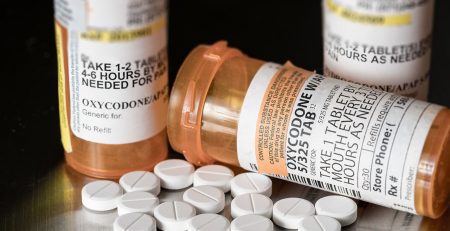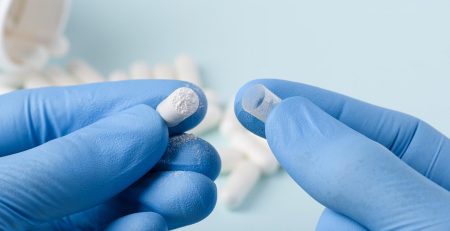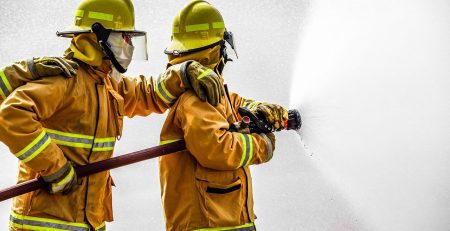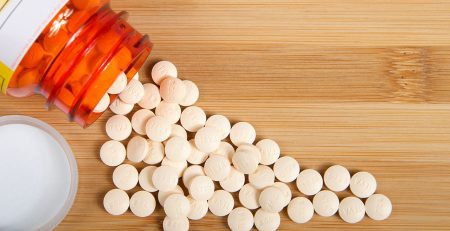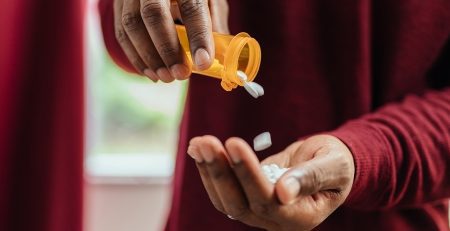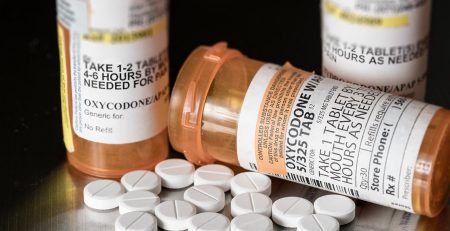There are various combination medications that incorporate opioids like hydrocodone with other medications to treat a variety of symptoms. Tussionex is one of many combination medications that utilize an antihistamine (chlorpheniramine) and an opioid (hydrocodone) to address a multitude of symptoms. However, while Tussionex can help treat people with upper respiratory problems and symptoms such as cough or pain, it also has a potential for abuse and addiction that patients should be aware of.
What Is Tussionex?
Tussionex is a prescription pain medication that’s made of a combination of an antihistamine called chlorpheniramine and the opioid painkiller hydrocodone. Tussionex is prescribed to treat respiratory symptoms related to allergies or colds, such as cough. Chlorpheniramine alleviates allergies and prevents fluid buildup in the respiratory tract. Hydrocodone is a narcotic medication that belongs to the opioid class of drugs and is designed to suppress coughing and relieve pain.
Both medications in Tussionex act on the central nervous system (CNS) differently to alleviate symptoms. For instance, hydrocodone acts on the CNS by attaching to opioid receptors to relieve pain and on the cough center (central pathway) in the brain to alleviate coughing. On the other hand, chlorpheniramine works by blocking the action of histamine, a substance in the body that causes allergy symptoms.
Tussionex may be prescribed to both children and adults in different doses. The recommended Tussionex dose for children is 5 mL or 1 tablet every 8 to 12 hours. In adults, the recommended Tussionex dosage is 5 mL every 12 hours, with a maximum daily dose of 10 mL. While it’s easier to prevent any abuse in children because parents usually manage prescriptions, in adults, Tussionex abuse is always a risk.
Tussionex Side Effects
It’s common for patients to experience some unwanted side effects when they start taking a new medication, as it may take a bit for their bodies to adjust. Additionally, while Tussionex is a beneficial medication, when patients do become accustomed to its effects, some people begin to abuse it for the “high” the drug can produce.
Common side effects of Tussionex include:
- Agitation
- Anxiety
- Back pain
- Confusion
- Constipation
- Decreased perception of pain
- Dizziness
- Drowsiness
- Drug cravings
- Dysphoria (a state of unease or dissatisfaction)
- Euphoria
- Fever
- Headache
- Mental clouding
- Mood swings
- Muscle tightness
- Nausea
- Relaxation
- Sedation
- Slowed breathing
- Stomach pain
- Swelling of the ankles, feet, or legs
- Tinnitus (ringing in the ears)
- Uncontrollable shaking
- Urinary retention and/or painful urination
Some potentially serious side effects of Tussionex that could occur can include:
- Agitation
- Chest pain
- Decreased libido
- Difficulty swallowing or breathing
- Fever
- Hallucinations
- Hives
- Irregular menstruation
- Itching
- Rapid heartbeat
- Swelling of mouth, eyes, lips, throat, etc
If you experience any severe side effects while taking Tussionex or any medication, speak to your doctor right away. These effects could potentially indicate a negative reaction.
Signs of Tussionex Addiction
Some people may begin abusing Tussionex to deal with stress or unwanted emotions, while others may abuse it for recreational use. There’s also a matter of tolerance and physical dependence, which can contribute to abuse and addiction.
Tolerance is when the body becomes accustomed to a particular dose of a drug, meaning the individual would have to take higher doses of the drug to feel the same effects. Long-term use of opioid-containing medications can also cause physical dependence, which is when the body becomes physically reliant on the drug to feel normal or “good.”
Dependence is also marked by withdrawal symptoms, which is how the body reacts when the drug wears off or when the person attempts to suddenly stop taking it. A combination of tolerance and the desire to avoid withdrawals can contribute to dangerous drug-taking behaviors and lead to addiction.
What makes Tussionex addictive is the opioid hydrocodone. Hydrocodone is one of the most frequently prescribed opioids in the United States and is linked with more abuse than any other opioid, according to the Drug Enforcement Administration (DEA).1 This also supports the claim that prescription painkiller addiction is common in the U.S.
Common signs of Tussionex abuse include:
- Taking Tussionex in higher doses than prescribed or for longer periods than directed.
- A history of unsuccessful attempts to quit or cut down.
- A large amount of time was spent acquiring, using, and recovering from Tussionex.
- Strong cravings for the medication.
- Repeated Tussionex use leads to failure to fulfill responsibilities at work, school, and/or home.
- Its use continues despite physical, psychological, or interpersonal problems that have worsened because of drug use.
- Tussionex takes precedence over other responsibilities.
- The drug is often used in hazardous situations, such as when the person is caring for their children or when they’re driving.
- Tolerance, or a need to use higher doses to feel the same effects.
- Withdrawal symptoms when Tussionex use is stopped or reduced.
Addiction or substance use disorder is marked by an inability to control one’s drug use, cravings, and drug-seeking behaviors despite the obvious and negative consequences. This problematic behavioral pattern results in significant impairment and distress in the individual’s life.
Finding Opioid Addiction Treatment Near Me
Considering opioids are among the most addictive pills in the world, receiving professional care is crucial for long-term recovery from opioid use disorder. If you or someone you care about has developed an opioid addiction, don’t wait to get help.
In this case, attempting an at-home detox to quit without medical support can be life-threatening. Instead, our high-end rehab recommends our medically monitored detox, which is led by a medical team of doctors and nurses who are trained and licensed to help patients safely recover from withdrawal.
Call Seaside Palm Beach today at 561-677-9374 to find out more about our opioid addiction treatment or residential addiction treatment in Palm Beach.
Source:
DEA – Drug Fact Sheet
Related Reading:


